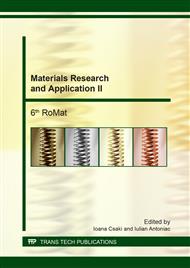p.20
p.26
p.34
p.39
p.45
p.53
p.69
p.75
p.80
Determination of Heat Input in Tungsten Inert Gas and Laser Welding of Type Optim 960 QC Structural Steel Using Adams’ Equation for 2-D Heat Distribution
Abstract:
The heat input during conventional arc welding processes can be readily calculated knowing the power taken from the power source. The efficiency coefficient can be taken from the appropriate literature standards. Here, the intention of the performed research work was to develop a procedure for determination of heat input in arc and laser welding processes implementing Adams equation - modified Rykalin equation for two dimensional heat distributions (2-D). To realize this idea, it is necessary to determine two characteristic temperatures points in the HAZ with known peak temperature, and to determine distance between them. Implementing measured values for distance in Adams’ equation, heat input in arc welding can be directly determined in arc welded joints.In laser beam welding, the absorption of the beam in the metal is not known, so that the welding heat input cannot be calculated directly, and direct implementation of Adam’s equation is not possible i.e. absorption coefficient has to be determined first, and after that calculation of heat input is possible.The peak temperatures corresponding to specific microstructures can be obtained by performing welding simulation, by the Gleeble 1500 simulator in our case. As one of the peak temperatures, the melting temperature can be used corresponding to the fusion line, so that at least one characteristic peak temperature such as coarse grain zone, fine grin zone, intercritical zone, recrystallization, has to be determined by the simulation.Performed research showed that obtained values for heat input using Adam’s equation correspond pretty well with standard equation for heat input in arc welding.
Info:
Periodical:
Pages:
45-52
Citation:
Online since:
August 2017
Authors:
Price:
Сopyright:
© 2017 Trans Tech Publications Ltd. All Rights Reserved
Share:
Citation:


